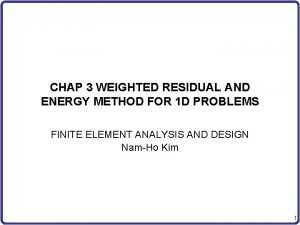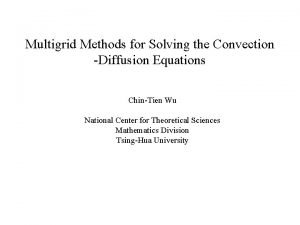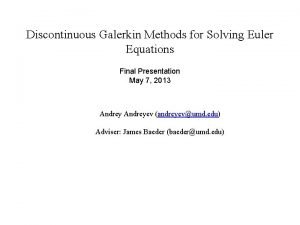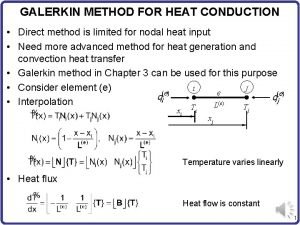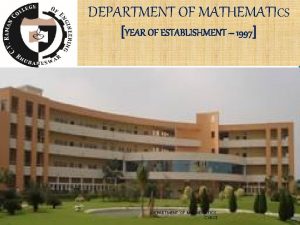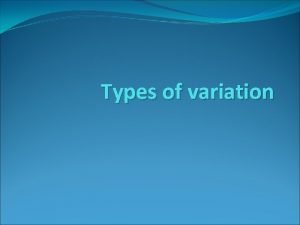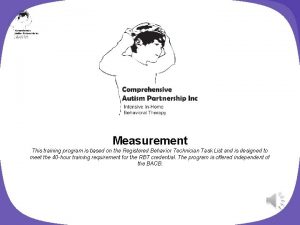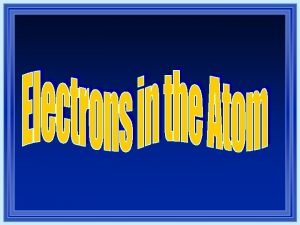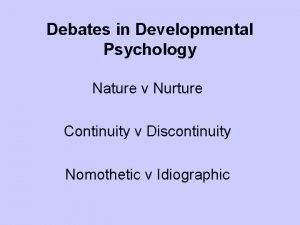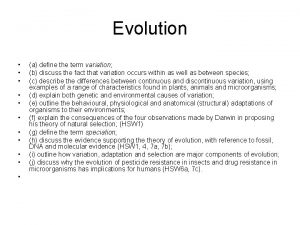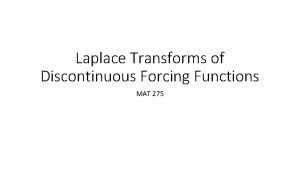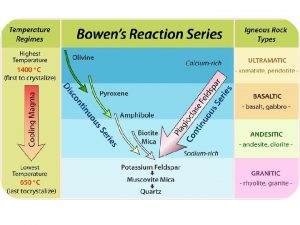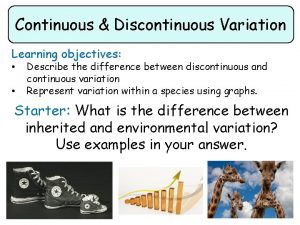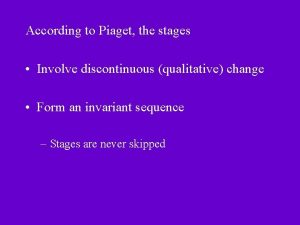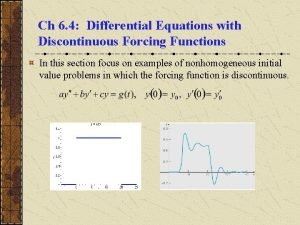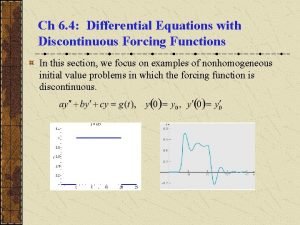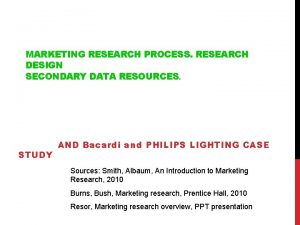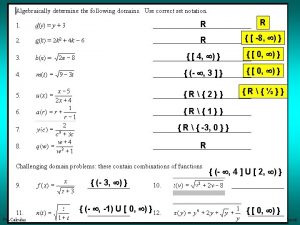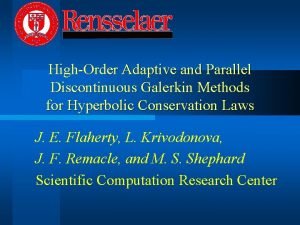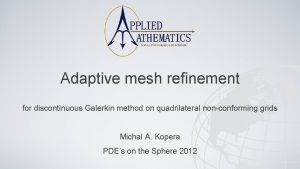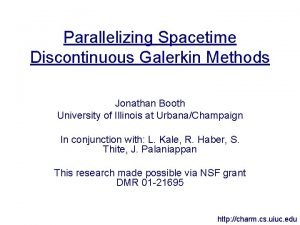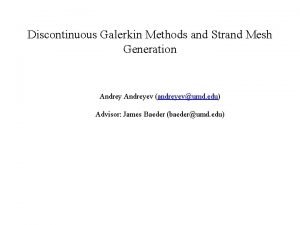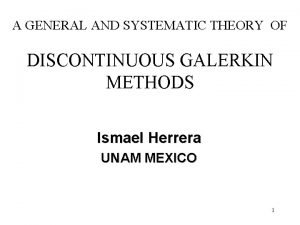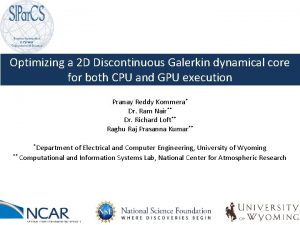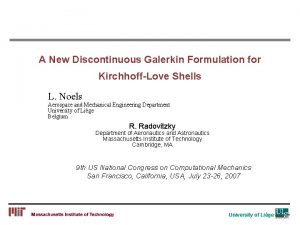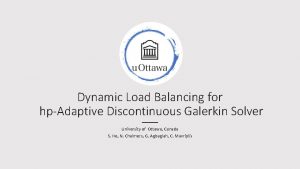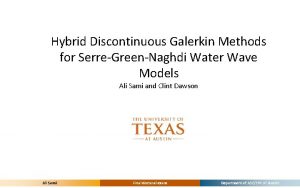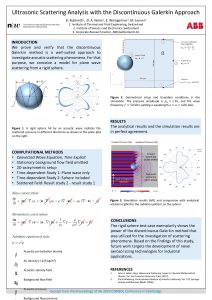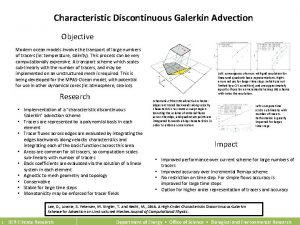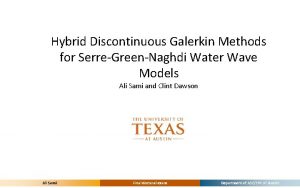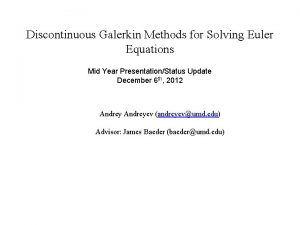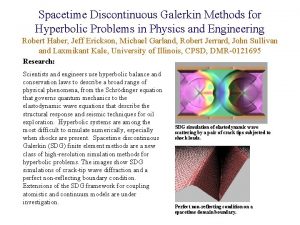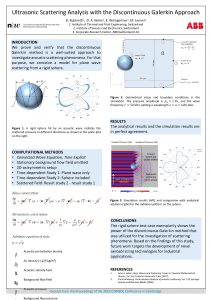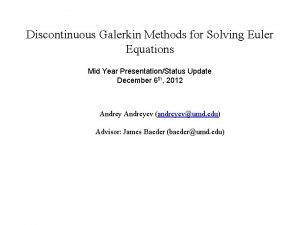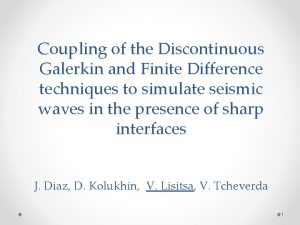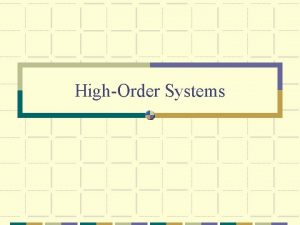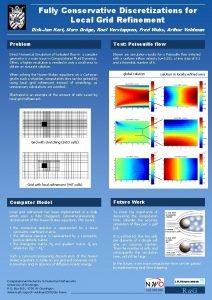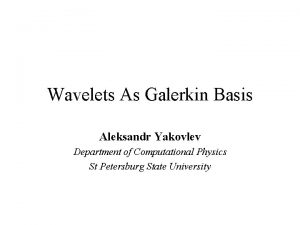Techniques for Highorder Adaptive Discontinuous Galerkin Discretizations in














































- Slides: 46

Techniques for High-order Adaptive Discontinuous Galerkin Discretizations in Fluid Dynamics Dissertation Defense Li Wang Ph. D Candidate Department of Mechanical Engineering University of Wyoming Laramie, WY April 21, 2009

Outline Introduction Objective Steady Flow Problems q High-order Steady-State Discontinuous Galerkin Discretizations q Output-Based Spatial Error Estimation and Mesh Adaptation Unsteady Flow Problems q High-order Implicit Temporal Discretizations q Output-Based Temporal Error Estimation and Time-step Adaptation Conclusions and Future Work

Introduction Computational Fluid Dynamics (CFD) q Computational methods vs. Experimental methods o Indispensible technology o Inaccuracies and uncertainties q Improvement of numerical algorithms o High-order accurate methods o Sensitivity analysis techniques o Adaptive mesh refinement (AMR) M. Nemec, et. cl. , Mach number contours around LAV (2008) L. Wang, transonic flow over a NACA 0012 airfoil with sub-grid shock resolution (2008) D. Mavriplis, DLR-F 6 Wing-Body Configuration (2006)

Introduction Why Discontinuous Galerkin (DG) Methods? q Finite difference methods o Simple geometries q Finite volume methods o Lower-order accurate discretizations q DG methods o Solution Expansion o Asymptotic accuracy properties: o Compact element-based stencils o Efficient performance in a parallel environment o Easy implementation of h-p adaptivity

Introduction High-order Time-integration Schemes q Explicit schemes (e. g. Explicit Runge-Kutta scheme) o Easy to solve o Restricted time-step sizes : o Run a lot of time steps q Implicit schemes o No restriction by CFL stability limit o Accuracy requirement o Accuracy o Computational cost Efficient Solution Strategies q q q Required for steady-state or time-implicit solvers p- or hp- nonlinear multigrid approach Element Jacobi smoothers

Introduction Sensitivity Analysis Techniques q Applications o Shape optimization o Output-based error estimation o Adaptive mesh refinement q Adjoint Methods o Linearization of the analysis problem + Transpose o Discrete adjoint method ü Reproduce exact sensitivities to the discrete system ü Deliver Linear systems o Simulation output : L(u), such as lift or drag o Error in simulation output: e(L) ~ (Adjoint solution) • (Residual of the Analysis Problem)

Objective Development of Efficient Solution Strategies for Steady or Unsteady Flows Development of Output-based Spatial Error Estimation and Mesh Adaptation Investigation of Time-Implicit Schemes Investigation of Output-based Temporal Error Estimation and Time-Step Adaptation

Model Problem Two-dimensional Compressible Euler Equations q Conservative Formulation

Outline Introduction Objective Steady Flow Problems q High-order Steady-State Discontinuous Galerkin Discretizations q Output-Based Spatial Error Estimation and Mesh Adaptation Unsteady Flow Problems q High-order Implicit Temporal Discretizations q Output-Based Temporal Error Estimation and Time-step Adaptation Conclusions and Future Work

Discontinuous Galerkin Discretizations Triangulation Partition: DG weak statement on each element, k Integrating by parts Solution Expansion Steady-state system of equations

Compressible Channel Flow over a Gaussian Bump q Free stream Mach number = 0. 35 q HLLC Riemann flux approximation Mesh size: 1248 elements q Pressure contours using p=4 p=0 discretization and p=4 p=0 boundary elements

Compressible Channel Flow over a Gaussian Bump q Spatial Accuracy and Efficiency for Various Discretization Orders Error convergence vs. Grid spacing Error convergence vs. Computational time

Compressible Channel Flow over a Gaussian Bump Element Jacobi Smoothers q Single level method q p-independent q h-dependent

Compressible Channel Flow over a Gaussian Bump p- or hp-multigrid approach q p-independent q h-independent

Outline Introduction Objective Steady Flow Problems q High-order Steady-State Discontinuous Galerkin Discretizations q Output-Based Spatial Error Estimation and Mesh Adaptation Unsteady Flow Problems q High-order Implicit Temporal Discretizations q Output-Based Temporal Error Estimation and Time-step Adaptation Conclusions and Future Work

Output-based Spatial Error Estimation Some key functional outputs in flow simulations q Lift, Drag, Integrated surface temperature, etc. q Surface integrals of the flow-field variables q Single objective functional, L Coarse affordable mesh, H q Coarse level flow solution, q Coarse level functional, Fine (Globally refined) mesh, h q Fine level flow solution, q Fine level functional, Goal: Find an approximation of without solving on the fine mesh

Output-based Spatial Error Estimation Goal: Find an approximation of Taylor series expansion without solving on the fine mesh

Output-based Spatial Error Estimation Discrete adjoint problem (H) q Transpose of Jacobian matrix q Delivers similar convergence rate as the flow solver Reconstruction of coarse level adjoint Approximated fine level functional q : Estimates functional error q : Indicates error distribution and drives mesh adaptation

Refinement Criteria is used to drive mesh adaptation Element-wise error indicator Criteria for refinement o Set an error tolerance, ETOL o Necessary refinement for an element if Flag elements required for refinement

Mesh Refinement h-refinement ◦ Local mesh subdivision p H P P p-enrichment P P h ◦ Local variation of discretization orders hp-refinement ◦ Local implementation of the h- or p-refinement individually p+1 H

Additional Criteria for hp-refinement For each flagged element: q How to make a decision between h- and p-refinement? h-refinement Isolate non-smooth solution regions p-enrichment Efficient performance Criteria? ? Local smoothness indicator q q Element-based Resolution indicator [Persson, Peraire] Inter-element Jump indicator [Krivodonova, Xin, Chevaugeon, Flaherty],

Subsonic Flow over a Four-Element Airfoil • Free-stream Mach number = 0. 2 • Various adaptation algorithms h-refinement ü p-enrichment Objective functional: drag or lift (angle of attack = 0 degree) ü • • Starting interpolation order of p = 1 • HLLC Riemann solver • hp-Multigrid accelerator Initial mesh (1508 elements)

Adjoint solution, Λ(2) Mach number contours Subsonic Flow over a Four-Element Airfoil Flow and adjoint problems target functional of lift Comparisons on hp-Multigrid convergence for the flow and adjoint solutions

h-Refinement for Target Functional of Lift Fixed discretization order of p = 1 Final h-adapted mesh (8387 elements) Close-up view of the final h-adapted mesh

h-Refinement for Target Functional of Lift Comparison between h-refinement and uniform mesh refinement Error convergence history vs. degrees of freedom Error convergence history vs. CPU time (sec)

p-Enrichment for Target Functional of Drag Fixed underlying grids (1508 elements) Spatial error distribution for the objective functional of drag Final p-adapted mesh discretization orders: p=1~4

p-Enrichment for Target Functional of Drag Comparison between p-enrichment and uniform order refinement Error convergence history vs. degrees of freedom Error convergence history vs. CPU time (sec)

Hypersonic Flow over a half-circular Cylinder Free-stream Mach number of 6 Objective functional: surface integrated temperature, hp-refinement Starting discretization order of p=0 (first-order accurate) hp-adapted meshes Final hp-adapted 42, 234 elements. Initial mesh: 17, 072 elements Discretization orders: p=0~3

Hypersonic Flow over a half-circular Cylinder Final pressure and Mach number solutions

Hypersonic Flow over a half-circular Cylinder Convergence of the objective functional

Outline Introduction Objective Steady Flow Problems q High-order Steady-State Discontinuous Galerkin Discretizations q Output-Based Spatial Error Estimation and Mesh Adaptation Unsteady Flow Problems q High-order Implicit Temporal Discretizations q Output-Based Temporal Error Estimation and Time-step Adaptation Conclusions and Future Work

Implicit Time-integration Schemes Time-Implicit System First-order accurate backwards difference scheme (BDF 1) Second-order accurate multistep backwards difference scheme (BDF 2) Second-order Crank Nicholson scheme (CN 2) Fourth-order implicit Runge-Kutta scheme (IRK 4)

Convection of an Isentropic Vortex q Initial condition q Isentropic vortex perturbation; Periodic boundary conditions q HLLC Flux approximation q p = 4 spatial discretization q ∆ t = 0. 2 BDF 1 (First-order accurate) IRK 4 (Fourth-order accurate)

Convection of an Isentropic Vortex q Temporal accuracy and efficiency study for various temporal schemes Error convergence vs. time-step sizes Error convergence vs. Computational time

Shedding Flow over a Triangular Wedge q Free-stream Mach number = 0. 2 q Unstructured mesh with 10836 elements q Various spatial discretizations and temporal schemes Unstructured computational mesh with 10836 elements

Shedding Flow over a Triangular Wedge q Free-stream Mach number = 0. 2 q Unstructured mesh with 10836 elements q Various spatial discretizations and temporal schemes Density solution using p = 1 discretization and BDF 2 scheme

Shedding Flow over a Triangular Wedge q t = 100 q Various spatial discretizations and temporal schemes p = 1 and BDF 2 p = 1 and IRK 4

Shedding Flow over a Triangular Wedge q t = 100 q Various spatial discretizations and temporal schemes p = 1 and BDF 2 p = 3 and IRK 4

Outline Introduction Objective Steady Flow Problems q High-order Steady-State Discontinuous Galerkin Discretizations q Output-Based Spatial Error Estimation and Mesh Adaptation Unsteady Flow Problems q High-order Implicit Temporal Discretizations q Output-Based Temporal Error Estimation and Time-step Adaptation Conclusions and Future Work

Output-based Temporal Error Estimation Same methodology can be applied in time q Global temporal error estimation and time-step adaptation q Implementation to BDF 1 and IRK 4 schemes q Time-integrated objective functional: q Unsteady Flow solution q Unsteady adjoint solution o Linearization of the unsteady flow equations o Transpose operation results in a backward time-integration Forward time-integration Current Backward time-integration

Output-based Temporal Error Estimation Two successively refined time-resolution levels q q H: coarse level functional h: fine level functional Approximation of fine level functional Localized functional error (for each time step i) BDF 1: IRK 4: Local time-step subdivision if

Shedding Flow over a Triangular Wedge Implementation for BDF 1 scheme ( p = 2) Validation of adjoint-based error correction Objective function: Drag at t = 5 q Error prediction for two time-resolution levels Refined timeresolution levels Computed functional error (Reconstructed adjoint) • (Unsteady residual)

Shedding Flow over a Triangular Wedge q Adaptive time-step refinement approach vs. Uniform time-step refinement approach q Objective functional: Error convergence vs. time steps (i. e. DOF) Error convergence vs. computational cost

Outline Introduction Objective Steady Flow Problems q High-order Steady-State Discontinuous Galerkin Discretizations q Output-Based Spatial Error Estimation and Mesh Adaptation Unsteady Flow Problems q High-order Implicit Temporal Discretizations q Output-Based Temporal Error Estimation and Time-step Adaptation Conclusions and Future Work

Conclusions High-order DG and Implicit-Time Methods q Optimal error convergence rates are attained for the DG discretizations q Perform more efficiently than lower-order methods q Both h- and p-independent convergence rates q An attempt to balance spatial and temporal error q Perform more efficiently than lower-order implicit temporal schemes q h-independent convergence rates and slightly dependent on time-step sizes Discrete Adjoint based Sensitivity Analysis q Formulation of discrete adjoint sensitivity for DG discretizations q Accurate error estimate in a simulation output q Superior efficiency over uniform mesh or order refinement approach q hp-adaptation shows good capturing of strong shocks without limiters q Extension to temporal schemes q Superior efficiency over uniform time-step refinement approach

Future Work Dynamic Mesh Motion Problems q Discretely conservative high-order DG q Both high-order temporal and spatial accuracy q Unsteady shape optimization problems with mesh motion Robustness of the hp-adaptive refinement strategy q Incorporation of a shock limiter q Investigation of smoothness indicators Combination of spatial and temporal error estimation q Quantification of dominated error source q More effective adaptation strategies Extension to other sets of equations q Compressible Navier-Stokes equations (IP method) q Three-dimensional problems
 Galerkin method
Galerkin method Galerkin
Galerkin Galerkin
Galerkin Galerkin method
Galerkin method Dirichlet discontinuous factor
Dirichlet discontinuous factor Discontinuous variation
Discontinuous variation Infants, children, and adolescents 8th edition
Infants, children, and adolescents 8th edition Permanent product recording aba
Permanent product recording aba Why are atomic emission spectra discontinuous
Why are atomic emission spectra discontinuous Discontinuity development
Discontinuity development Physiological adaptation example
Physiological adaptation example Lifespan development a psychological perspective
Lifespan development a psychological perspective Discontinuous forcing functions
Discontinuous forcing functions Bowen reaction series
Bowen reaction series Graph of discontinuous variation
Graph of discontinuous variation Discontinuous trait
Discontinuous trait Piaget discontinuous development
Piaget discontinuous development Differential equations with discontinuous forcing functions
Differential equations with discontinuous forcing functions Difference between continuous and discontinuous variation
Difference between continuous and discontinuous variation Differential equations with discontinuous forcing functions
Differential equations with discontinuous forcing functions Discontinuity of development
Discontinuity of development Artificial selection vs natural selection
Artificial selection vs natural selection Continuous panel vs discontinuous panel
Continuous panel vs discontinuous panel Fonction technique scooter
Fonction technique scooter Vad är ett minoritetsspråk
Vad är ett minoritetsspråk Fimbrietratt
Fimbrietratt Frgar
Frgar För och nackdelar med firo
För och nackdelar med firo Vilket tal pekar pilen på
Vilket tal pekar pilen på Underlag för särskild löneskatt på pensionskostnader
Underlag för särskild löneskatt på pensionskostnader Toppslätskivling effekt
Toppslätskivling effekt Returpilarna
Returpilarna Redogör för vad psykologi är
Redogör för vad psykologi är Borra hål för knoppar
Borra hål för knoppar Bra mat för unga idrottare
Bra mat för unga idrottare Gumman cirkel sång
Gumman cirkel sång Bris för vuxna
Bris för vuxna Etik och ledarskap etisk kod för chefer
Etik och ledarskap etisk kod för chefer Offentlig förvaltning
Offentlig förvaltning Indikation för kejsarsnitt på moderns önskan
Indikation för kejsarsnitt på moderns önskan Datorkunskap för nybörjare
Datorkunskap för nybörjare Plagg i gamla rom
Plagg i gamla rom Fspos
Fspos Rita perspektiv
Rita perspektiv Ministerstyre för och nackdelar
Ministerstyre för och nackdelar Bästa kameran för astrofoto
Bästa kameran för astrofoto Sju principer för tillitsbaserad styrning
Sju principer för tillitsbaserad styrning
